
Sunday, July 30, 2006
AIRNEÁL: LAST DAY IN GLEANNCHOLMCILLE

I took this self-portrait with Treasa at 5:30am as the sun was coming up. We stayed up all night singing. We had a session at our house, Treasa played her squeeze-box, Mary played the tin-whistle and Sally played her bodhran when she came home from the pub session and her real friends. Crianna told a story and Pat recited her "bilingual" poem of "Micheal Bocht and City Suzy". Everybody else sang a song. We had a great night. Towards the end Dennis came back from the pub for more singing. We sang all the songs we learned in the sean-nos class, especially Gardaí an Rí which we sang about a hundred times. Eventually everybody else left or went to bed. Only Treasa and myself were left singing when the dawn came up. We made a spit-promise that wherever we would be we would support each other in our singing, like the Connemara singers who wind up each other as they sing.
Saturday, July 29, 2006
OILITHREACHT: TURAS CHOLMCILLE = ST. COLMCILLE’S PILGRIMMAGE ROUTE

I went out with a group from my class to do part of the Turas CholmCille. We were taken out by Paddy Beag. We started by investigating the souterrain. Paddy said that it dated from the 700’s when there was monasatic settlement. They used the souterraine to keep things like butter cool, but it was also used as a place of hiding when Vikings were spotted in the bay. I went down into the hole to take a look. One thing that surprised me is that there is a big wooden door with a lock on the souterrain now, which wasn;t there before. Inside, there is very little to see. I had to crouch down to crawl through to the end, about 10 feet from the entrance. One part goes under the graves in the churchyard, and the other end goes under the burial mound that is the first stop on the Turas. It’s likely that the souterrain was originally part of a passage grave.
We followed Paddy up past the second and third stops on the Turas. At the third stop he explained that this was one of the places where prayers were said and a rock passed around the body three times. He said that there was another stone that was placed on the eyes as a cure for any eye problem but this stone was now lost.
We followed Paddy up the hill to stations 5, 6 and 7. At St. ColmCille’s church he showed us the stone walled enclosure that was probably a living space. Nearby was the church and St. ColmCille’s bed. I lay down on the stone slab. I can’t imagine the saint having too many pleasant nights’ sleep there. I turned around three times on the slab as directed but I’m not sure what illness that was a cure for.
We continued up to the sacred well. At the well we all had a drink, some more reluctantly than others since the cups looked like they had been left by the saint himself and the water was the same murky, peaty brown as all the water in the Glen.
At this point we stretched out on the grass with the view of the valley below us. Paddy told us the whole story of the life of St. ColmCille. He was a high-born prince of the O’Domhnaill family, the kings of Tir Chonaill, or Donegal. He copied the manuscript of the Psalms from the book of St. Finnian who demanded both the original and the copy back. When the high king of Ireland gave his famous ruling against St. ColmCille (to every cow it’s calf, to every book it’s copy) he fled to Donegal where the O’Domhnaill’s massed an army on his behalf. In a great battle in Sligo more than 3000 people were killed.
St. ColmCille accepted exile as penance for his part in this slaughter. He sailed to Scotland and set up the monastery at Iona.
Paddy told one other story about ColmCille that was interesting. It seems he was called back to Ireland to adjudicate a problem of the bards. He spent a year in Ireland but to comply with his oath he was blindfolded the whole time so he could not see Ireland and he put clods of dirt form Scotland in his sandals so he would not tread on the soil of Ireland either.
GRIANGHRAF AN LAE: SUNDAY MASS
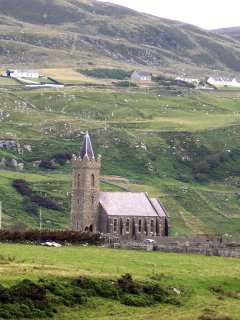
Yesterday I attended the Protestant church service in the village. The minister is not resident in the parish. He comes from over the hill every Sunday to provide services to the dwindling number of Protestants in this part of Donegal. There were less than ten people at the service, all relatively old. In the past, the minister’s assistant played the organ but now they have a boombox to provide musical accompaniment to the hymn and psalm singing. I wondered if they chose the particular psalms for that Sunday based on the music they had available on a CD or if there was a liturgical thread through the selections. I suspect the former.
The sermon was a meditation on the historical significance of the Ark of the Covenant to the Jews. Somehow, the minister wove in his personal opinions about the revisions to the Book of Common Prayer. I felt I was witness to a skirmish in the Lace and Old Lady Wars. He postulated that the purpose of the revision was to encourage participation by ordinary people in the liturgy but he concluded that he hadn’t seen any difference in that regard. I think he was an traditionalist who was a little pissed that somebody had made a change to his Old Familiar.
One of the readings from the Gospels was on the death of John the Baptist. I am more familiar with the Salome version of that story so I was a little surprised by how it was described in the Gospel. It seems Herod had JtheB as an advisor on spiritual matters but when he started preaching against kings marrying their brother’s wives Herod became a little uncomfortable. He had JtheB imprisoned. The daughter of Heroditus (Herod’s brother’s former wife) took umbrage and asked for his head to be presented to her on a platter. Herod obliged. I’m not sure what the point of the story was but I sure am not going to complain too loudly if my brother marries my ex-wife.
GRIANGHRAF AN LAE: MAGAIRLIN MEIDHREACH = MERRY LITTLE TESTICLE

I was going to Killybegs yesterday so I asked Beryl and Madeleine if they would like to come along. Beryl said she was going swimming but would like to go the next day. I picked her up at lunchtime then went looking for Madeleine. Her class is at the main campus whereas our classes are in the National School building at the other end of the village.
We struck out for Killybegs in the car – my second time in as many days. Beryl requested that I drive like an Irishperson so that we could get there fast. Unfortunately that didn’t suit Madeleine who was carsick in the back.
When we got to Killybegs our first order of business was to find a pharmacy for lactose intolerance pills for Madeleine. We easily found the pharmacy and everything else in this two-street town. But of course it was closed for lunch so we went awandering about the town. Beryl and Madeleine wanted to find someplace to eat but the first place we went to was too much for Beryl’s fish allergy. What a bummer, to be allergic to fish in Ireland’s premier fishing port.
We decided to go shopping at the supermarket instead. They had a deli for the two girls to get something to eat in plastic containers. I bought some things for baking and when I got my change back I thanked the shopkeeper in Irish. She said she didn’t speak any Irish but I continued speaking to her in Irish and she understood well enough. By the end of the conversation she was trying to talk to me in Irish. Seosaimh’s theory is ccorrect.
On the way back to the Glen we stopped at St. Kieran’s Well with the intention of walking out to see the court tomb that is nearby. When we got there we realized that it was further away than we had thought and the field was quite marshy despite the fine weather for the last few days. We decided to give it a miss this time.
We also stopped at the Spaniard’s Church to find out why it was called that but again we were thwarted in our plans – this time by a locked gate.
STAIRBHEO: FAMINE GRAVEYARD

I found this little piece of ancient history on the outskirts of Donegal Town. I was walking out past the Catholic Church just to see what there might be out there. I saw a sign for a Famine Graveyard and decided to follow where it pointed. But all there was there was a big open field with a small walled enclosure. In the center of the enclosure was a tall wooden cross. Outside the enclosure set into a gap in the wall was this plaque.
In some ways it reminded me of the plaques I saw all over Paris commemorating the Jews who were deported and murdered by the Nazis with the aid of the Vichy government: the crime is boldly stated without any context for later generations to make sense of how it came to pass. In another way, though it was very different. The field is not really a graveyard – there is nothing else there that you would expect to find in a graveyard, no headstones, no marked plots, no well tended paths between burial sites. Only this marble slab reminds us of the pain and suffering that many people endured, but even that is almost forgotten as this little corner of a painful history is itself pushed to the margins of consciousness. Next time I come through here I expect there will be a holiday bungalow village on this site.
STAIRBHEO: DONEGAL CASTLE
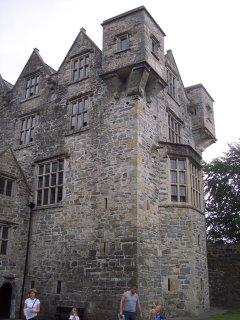
I took the tour of Donegal Castle, as I always do when I'm in Donegal. I drove in to Donegal Town from GleannCholmCille on Saturday after the first week of the Summer School. Beryl and Madeleine came along for the ride. I asked Yvonne from London if she would like to join us for the day. It took about an hour to drive straight through from Gleann to Donegal.
As soon as we got to Donegal there was a problem. I wanted to go off by myself and spend the day alone investigating the town. The women wanted us to spend the day together doing everything together. They were worried that they might not be able to find me when it was time to go home - a typical American anxiety, the need to bond closely to the familiar in foreign places. I was having none of that. How can you get lost in a place as small as Donegal Town? I told them to meet me at the car at 5 o'clock - that I wouldn't leave without them!
The castle was the highlight of my day, though I did see some other interesting things in Donegal. I never get tired of hearing the story of the O Domhnaills and the O Neills. I love the history of that time, of how the O Domhnaills developed trade with Spain and France, then later prevented the English from completely dominating Ireland during the Nine Years War. I like the metaphor of Donegal holding out when the rest of Ireland has succumbed to the Gold Rush ethos.
The guide touched on the story of ColmCille and the copied manuscript. A copy of the manuscript is in the castle but the original is in Dublin, along with the bejeweled ark of precious metel that was made to house it. Since ColmCille was an
O Domhnaill the O Dohmnaills got possession of the manuscript when they came to power in the 12th century. It was their greatest possession and was always carried at the head of the army into any battle, hence the name An Cathach, or the Battler. The Cathach assured them of victory, at least until the final great battle at Kinsale in 1601. The defeat of the Irish, really the O Domhnaills and their Spanish allies, precipitated the Flight of the Earls and the end of the Gaelic order.
Monday, July 24, 2006
GRIANGHRAF AN LAE: AG DUL AR SCOIL ME

July 18, 2006
My class is in the national school but everyday we go outside in the afternoon because the weather is so fine. The school is very strange with a picture of the pope to greet you at the entrance and pictures of the Sacred Heart or the Last Supper or something similar in every classroom.
When we are outside I can’t help thinking about Weavers’ Square. I remember we would go outside on a fine day to play cat-and-mouse or to do watercoloring. I don’t remember any picture I produced in that time and I imagine in a few years I won’t be able to remember anything I learned in the school yard of Scoil Náisiunta Naomh Cholmcille.
DONEGAL TOWN

July 15, 2006
I got on the road at about noon. I drove straight through Kells and Navan. In Cavan I stopped briefly to find the crystal factory. The hotel that was being built last time we were there is all finished. Now the showroom is a wing off the hotel. I didn't linger in Cavan because the road into the center was backed up. I decided I would see it on the way back or do a day trip out of Dublin and take in Tara and the Boyne Valley at the same time. I zipped up the N3 to Enniskillen. Again, because it was Saturday and such a fine day everybody wanted to be in town so I decided to bypass it. I took my time driving along the lake. It was such a beautiful day.
Finally, I got to Donegal Town at about 4:15 in the afternoon. I headed straight to the Blueberry Cafe for some lunch. I talked with the owner, Brian who remembered Rich and Vladimir from the last time they were here. I did a little shopping and walked around the town. The castle was already closed. I bumped into Sean from Milwaukee and chatted briefly. Things were starting to close up when I set out again for GleannCholmCille. I took my time driving through Killybegs and Kilcar. I was hoping that I could buy some fish from the boats in Killybegs but by the time I drove through there wasn't much going on.
Friday, July 14, 2006
SIÚLÓID: BASTILLE DAY

Timmy and Helen decided to join me for a walk around Dublin city center today. We parked the car in the Jervis Centre and walked across the Halfpenny Bridge into Temple Bar. I took some pictures of Trinity College and the Bank of Ireland building, then walked up Grafton Street to the gallery on Molesworth Street where Joe’s exhibition is. We checked out the exhibition then walked back to Wicklow Street to have lunch.
Before we left town, we walked down Henry Street to find the church where Wolfe Tone was baptized. A few years ago the church was gutted and turned into a nightclub. Now it is a fancy bar and restaurant though it looks like some restoration has taken place. It seems very sad to me that Ireland’s greatest connection to the French Revolution has been forgotten. But what is even sadder to me is that the historical record embedded in the architecture of Dublin is rapidly disappearing along with some of the most beautiful buildings in Europe. Romantic Ireland’s dead and gone . . .
Thursday, July 13, 2006
GRIANGHRAF AN LAE: SACRE-COEUR

Last day in Paris for me. We had breakfast at a little zinc bar close to our hotel. For some reason the waiter brought us two rounds of tartines – buttered baguettes that we liberally applied strawberry jam to. As we were walking along Blvd. des Italiens we caught a glimpse of Sacre-Coeur. It didn’t take much persuading to decide on a visit.
We took the Metro to Abbesses then walked to the funiculaire. Along the way we passed a girls’ school with commemorative plaque for the 700 Jewish children who were deported to the death camps – a sobering moment of reflection.
The funiculaire was a short one euro ride – we could easily have walked up to the top. Along the way we listed all the funiculars we have ever ridden on: Angels’ Flight in Los Angeles, Lake Tahoe, Lisbon, and Guanajuato.
Tuesday, July 11, 2006
SIÚLÓID: BRUGGES, A GREAT DAYTRIP
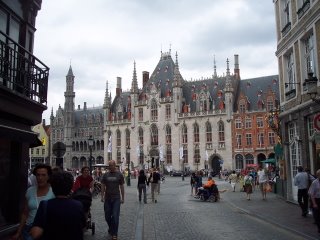
After several days in Paris we were looking to experience something different in Belgium. We knew we would be there for just one day (really just eight hours) so we would have to get an immediate feel for the place. After leaving Lille we began to notice something different as soon as we crossed the border. All the signage was in Flemish and as people got on the train at various stops we heard more and more Flemish. I think we were a little surprised by that - I had expected that people would be speaking French.
From the train station to the center was a long walk through a beautiful park. It was obvious from the numbers of bikes parked outside the train station that Brugges is a biking city. There were bike paths through the park with lots of people using them.
At the center we were again surprised. A huge open square lined with cafes dominates the city center. Narrow cobblestone streets lead off the square. Everywhere are beautifully preserved buildings from Brugges' glory days as the leading wool trading center in Europe.
We took a minibus tour of the city to get a feel for the history. We learned about native son Jan Van Eyck, the Calvinistic period, the French Revolutionary period when the main cathedral was destroyed, and the rise in sea level that ended Brugges' development as a rival to London and Paris. We also saw where the first stock exchange and banking system came into being.
We were very glad we took the time to stray from our itinerary to explore this beautiful city.
Monday, July 10, 2006
AG LÉAMH: A VERY GOOD BOOK by Vladimir
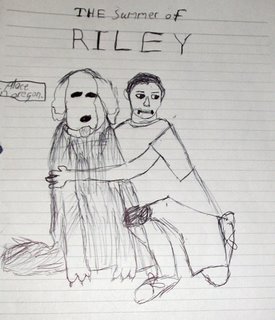

THE SUMMER OF RILEY
by Eve Bunting
I read this book in Paris. I loved this book so much that I couldn't put it down until I finished it completely. My favorite part of the book was when they first got Riley from the pound. I would definately read another book by this author, Eve Bunting.
This story is about a dog named "Riley" who is on trial, his owner William, and William's best friend Grace. One Summer day Riley, Will and Grace went to visit Will's next-door-neighbor Ms. Peachwood (Peachie) and her horse, Sultan. Riley got loose and chased Sultan. Sultan had hurt his leg while running away from Riley. Peachie called Animal Control to have Riley put down (In Oregon, where this story is set, chasing livestock is enough to have a dog put down.) Riley had five days until his execution. William had made an appeal to the Governor to save Riley's life. The Governor changed the waiting period to 21 days.
What do you think will happen to Riley? Will he be killed, or will he live?
(Write me a comment with your thoughts.)
Sunday, July 9, 2006
GRIANGHRAF AN LAE: LILLE

Our day started badly. We got up early, made it to the Metro, changed trains at Chatelet, and made it to Gare du Nord in plenty of time for our 7:58 train to Brugges, Belgium. Unfortunately, the train left without us because our clocks were set to Reykjavik time. Vladimir had warned us that there was a one hour time difference between Rekjavik and Paris but like parents everywhere we took no notice of the child.
All was not lost. We were able to take a later train but with a 90 minute layover in Lille. And to our pleasant surprise, Lille was a lovely place to walk around for 90 minutes. We got to see the Palais des Beaux Arts, the Hotel de Ville, the Porte de Paris, and the Grand Place at the center of the city. We didn’t have time to explore the old city and the cathedral but we took a ride back to the train station on one of Lille’s two metro lines. We would definitely come back to spend more time exploring Lille on a future trip, perhaps on the way to Amsterdam.
On the way back through Lille we ran into World Cup Fever. Huge crowds were gathered around giant TV screens right in the plaza in front of the train station, blocking access. We had to wind our way around secret passageways to get into the train station. But we did, and got on the train in time. By the roars of the crowd, it seems that France was winning 100 – 0.
Saturday, July 8, 2006
RADHARC ÓN ÓSTÁN: VIEW FROM OUR HOTEL

We are staying at a little hotel on Rue de Richelieu in the first arrondissement. Down the block is the Bibliotheque National. Below us on the street is a great bakery and a laudromat. We are very close to the Moliere fountain and the Comedie Francaise. A little further down the street is Palais-Royale and the Louvre.
It can be very noisy here during the day but at night things are a little quieter. This is a great neighborhood to walk around, even late at night. We have stayed before at another hotel on this street, the Hotel Montpensier. This is our favorite part of Paris because it is within walking distance of all the major attractions.
Thursday, July 6, 2006
THE GOLDEN CIRCLE by Vladimir

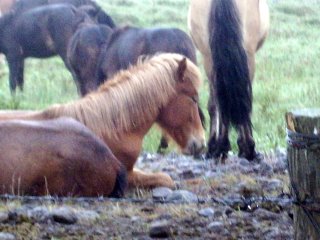
The last big thing we did in Iceland was a bus tour of the Golden Circle. This was an eight hour tour of Kerid extinct volcano with a lake inside, a small waterfall that had a salmon ladder, Gullfoss waterfall, the Great Geyser, and a national park where we could see the North American Plate separating from the Eurasian plate.
My favorite part of the Golden Circle tour was the Gullfoss waterfall. This inspired me because it had very rapid waters. There was a lot of spray as the water fell over the cliff and hit the bottom far below.
The geysers were my second favorite thing on the tour. The geysers put on a show for us. They erupt every 15 minutes. The whole area smells like rotten eggs because of the sulphur in the water.
GRIANGHRAF AN LAE: THE BLUE LAGOON
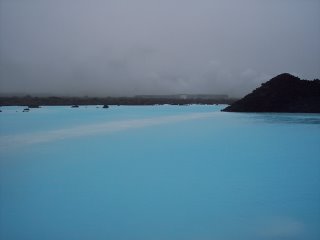
The Blue Lagoon is hard to describe. It is an eerie moonscape that appears to have been created millions of years ago in Iceland's volcanic past. It is actually an artificial lake built around a geothermal power plant. Hot water is pumped up from a mile beneath the surface. It mixes with seawater. Algae in the seawater paint it a deep blue and the steam rising off the surface shrouds everything in a fine mist. White silica mud oozes between your toes as you wade around the shallow pools.
The Blue Lagoon is on the way to the airport so we were able to take the FlyBus out there for a spa beauty treatment. It seems that lots of people stop off here on their way out of the country.
The water is a constant 40°C but the air temperature on the day that we were there was more like 8°C. We waded in the pools, scooping up handfuls of the white silica to smear on our faces as a mudpack. In between treatments, we scurried across the lava walkways to the sauna and the steam room.
We are all agreed that the Blue Lagoon is an experience not to be missed.
Tuesday, July 4, 2006
RADHARC ÓN ÓSTÁN: MIDNIGHT SUN

Our hotel is in an industrial section of Reykjavik. I took this picture from our hotel room at 3am in the morning to show how light it is at that time. It never gets dark here during the Summer. I knew that before I came but it is still strange to experience it. Trying to sleep here reminds me of the time when I might be sent to bed early as a punishment for a childhood crime (Do I need therapy?)
GRIANGHRAF AN LAE: FASCINATING MURAL by Vladimir


This mural caught my interest because it looks so colorful. One thing about it that I really liked the picture of the puffins. I've always wanted to see a puffin in real life. I liked how they used the map of Iceland in this mural. We came across this mural in the area downtown close to the harbor. I never got to see a puffin because we never went to that part of Iceland but I'm looking forward to seeing one next time.
"THERE'S AN IRISH PUB IN EVERY TOWN"

This is the Dubliner pub in downtown Reykjavik. Unfortunately, it was closed when we dropped by at lunchtime so we will never know if it is run by Icelanders or Irelanders. It reminds me of the Irish pub in San Miguel de Allende "Limerick Pub" which was run by people from Oaxaca.
Monday, July 3, 2006
SIÚLÓID: FIRST DAY OUT


We ventured out into downtown Rekjavik today for the first time since arriving. The flight from San Francisco was long and tiring. We arrived on Sunday in the afternoon local time. We checked out the neighborhood of our hotel and then went to bed. It never got dark during the night so sleeping was another challenge.
The picture shows us outside the Cathedral, a very strange shaped building. Most Icelanders are Evangelical Lutheran. When you understand that then the architecture starts to make sense.
Saturday, July 1, 2006
GRIANGHRAF AN LAE: BON VOYAGE

We are hanging round waiting for Vitaly to pick us up and take us to the airport. Seems like we've been hanging around all day. Our bags are packed - have been packed for the last three days.
We have been waiting for the hibiscus to flower. Last week we noticed small buds tucked among the leaves. This morning a beautiful flower had opened and by the afternoon another bloom was dazzling. I wonder what will be flowering when we get back.
Subscribe to:
Posts (Atom)